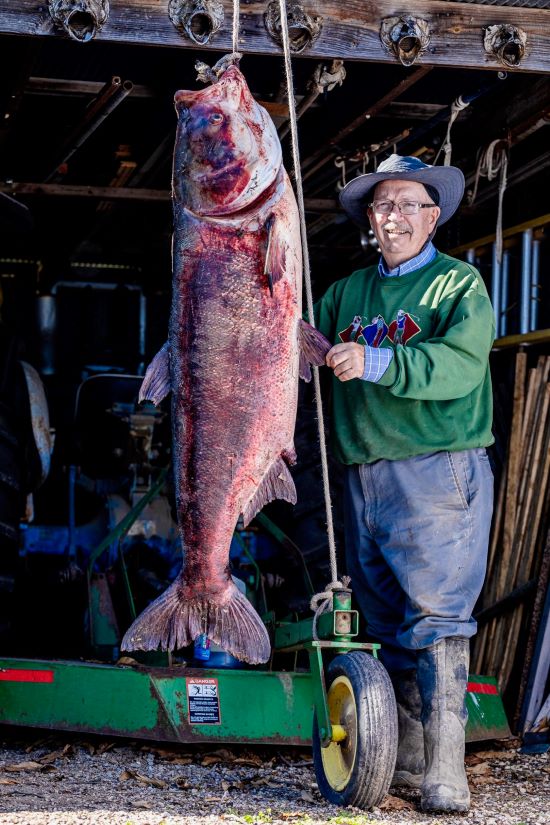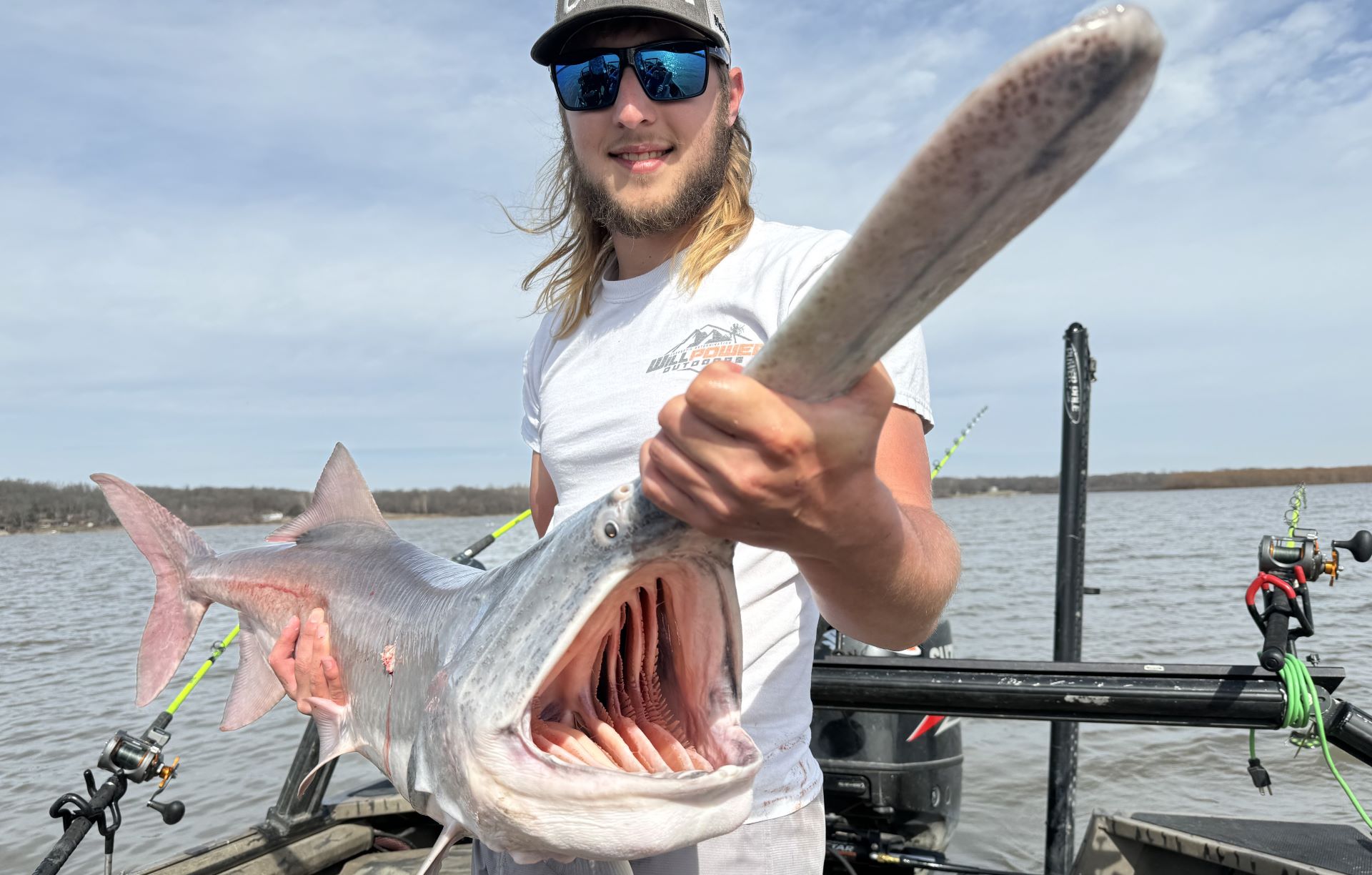Missouri Angler Lands Monster Invasive Carp, Buries It Plague of River Ecosystems
 Kasey Whiteman of the Missouri Department of Conservation holds proof that invasive silver carp can grow to large sizes. This one weighed close to 60 pounds. (Courtesy | Kasey Whiteman)
Kasey Whiteman of the Missouri Department of Conservation holds proof that invasive silver carp can grow to large sizes. This one weighed close to 60 pounds. (Courtesy | Kasey Whiteman)
Published April 26th, 2024 at 6:00 AM
When George Chance caught a potential world-record fish in March, he didn’t do a lot of celebrating.
It wasn’t like he caught a highly sought-after bass, crappie or catfish. Instead, he landed a 97-pound bighead carp, an invasive species that is scorned by fisheries biologists in Missouri and surrounding states.
Yes, it was a gigantic catch, the biggest freshwater fish Chance had ever reeled in. But instead of rushing to the taxidermist, Chance buried his fish in his garden to serve as fertilizer.
“I didn’t want that big ugly thing hanging on my wall,” said Chance, 78, who was fishing in a slough off the Mississippi River near his hometown of Festus, Missouri. “I’ve already planted a couple of rows of tomatoes over the spot where I buried it.”

Chance won’t forget the fight the giant fish put up. He was casting for big flathead catfish when the carp hit the crankbait he was retrieving.
“I caught flatheads weighing 45 and 35 pounds three days before that,” Chance said. “I thought I had another one.”
Instead, he had one of the rough fish Midwest fisheries biologists label Public Enemy No. 1 — an invasive carp.
Four species go under that heading — silver, bighead, black and grass.
All made their way from Asia into Midwestern rivers after being inadvertently released from aquaculture operations. Some of those fish farms raised the carp for fish food, fish oil, fertilizer or even human consumption.
The carp made their way into major riverways during floods. And it was like Frankenstein had been released.
The invasives thrived in their new home, overpopulating rivers such as the Mississippi and the Missouri. By the early 2000s, it was obvious that Missouri, Kansas and surrounding states had a problem.
That problem has only gotten worse with time.
“Silver carp are highly, highly abundant in just about every river they get into,” said Joe McMullen, big river specialist for the Missouri Department of Conservation. “They’re a real threat to our native species.”
How? The invasive carp are filter feeders, meaning they feed heavily on plankton. The fry of native species also rely on plankton, meaning they compete for the same food source. Adult species such as paddlefish, buffalo and gizzard shad also rely on plankton.
Simply put, there are concerns that the invasive carp will take up too much biomass. That is especially a concern if the invasive fish get into smaller bodies of water.
Jumping Fish
If you doubt the silver carp’s abundance, try running your boat through a side channel off of the Missouri or Mississippi rivers.
Dozens of startled fish jump out of the water, like kernels of popcorn in a pan.
“They spook very easily,” said Kasey Whiteman, a fisheries researcher for the Missouri Department of Conservation. “Because they’re filter feeders, they look for that warm, slower-moving water.
“They can gather in those areas in impressive numbers.”
The silver carp brings a new mean to the fisherman’s saying, “They were jumping into the boat.”
A Plague on Missouri Waterways
Anglers have been injured when they have been clobbered by the flying fish. Reports of anglers being knocked out or absorbing blows to the chest or legs aren’t uncommon.
Silver carp are by far the most abundant of the invasive species. They don’t grow nearly as large as the bighead or grass carp. But there is strength in numbers.
Massive schools of two- to five-pound fish have been reported in the major river systems. As for size, there are exceptions to the rule.
Whiteman remembers sampling one silver carp that weighed almost 60 pounds.
“It had a head as big as a football helmet,” he said.
Culling the Herd
Fisheries officials have declared war on the invasive species.
Large-scale programs in which state and federal agencies collaborate to remove large numbers of carp have found success.
Last October, the Missouri Department of Conservation joined with Illinois and the U.S. Fish and Wildlife Service to provide more financial incentives to commercial fishermen to harvest the invasive carp and get them out of the Mississippi River.
A staggering 1 million pounds of carp, mostly silvers, have been harvested in that short amount of time.
“If we can make harvesting of these invasive carp economically viable for commercial fishermen, maybe we can make a dent in populations,” McMullen said.
Other removal projects have also found success. Whiteman led a program to reduce populations of silver carp in the Grand River near where it joins the Missouri River.
Research showed that silver carp were abundant in the Missouri River, but they were hard to target because of the river’s size. So, Whiteman and his crew shifted their attention to the lower six miles of the Grand, which also had a sizeable population of the invasive species.
They closed part of the Grand by putting large nets at both ends of the six-mile stretch and went to work removing the invasive carp.
In September 2022, the Department of Conservation got 25,000 pounds of mostly silver carp out of the river. The crew returned to the same stretch a year later and collected 36,000 pounds.
“We tested for density a week before our removal effort and a week after and we found that the population was significantly lower,” Whiteman said.
“That gives us hope that in these small specific areas we can reduce the population of invasive carp that live there.”
A Tough Battle
Still, containing the invasive carp isn’t easy.
Recreational fishermen aren’t much help. Because the invasive carp feed mostly on plankton, they rarely strike on traditional bait.
Though Chance caught his fish in the lip, fisheries biologists say that seldom happens. They urge anglers not to throw the invasive carp back when they catch one.
They even have programs to show how to clean and prepare the carp for the dinner table.
Meanwhile, officials continue to search for ways to give the carp value and incentivize their removal.
“I think we are making some progress,” McMullen said. “But there’s still a long way to go.”
Brent Frazee is an award-winning writer who freelances for magazines, newspapers and websites. He lives in Parkville with his wife Jana and his two yellow labs, Millie and Maggie.



